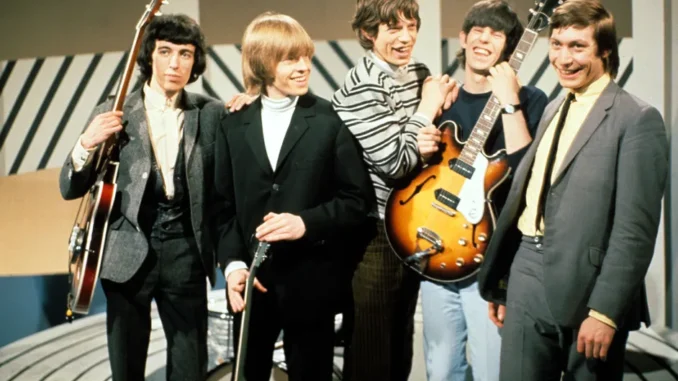
Sex, Drugs, and Mystery: Uncovering The Rolling Stones’ Dark History

The Rolling Stones, an iconic rock band formed in London in 1962, has captivated audiences worldwide for over six decades. Known for hits like “Paint It Black,” “Sympathy for the Devil,” and “Gimme Shelter,” their rebellious spirit and provocative lyrics have made them a symbol of rock and roll’s dangerous allure. But behind the music and the fame lies a complex history filled with controversy, excess, and secrecy. Let’s delve into some of the lesser-known, darker tales of The Rolling Stones and uncover the secrets that shaped their tumultuous journey.
The Drug-Fueled Years: Addiction and Arrests
The Rolling Stones’ relationship with drugs has always been well-documented, but the extent and impact of their substance abuse often went far deeper than the public knew. By the late 1960s, drugs were not just a recreational pastime but a core part of the band’s lifestyle. Mick Jagger, Keith Richards, and Brian Jones were known to indulge heavily, which quickly became a part of their bad-boy persona.
Keith Richards, in particular, became infamous for his heroin addiction. His dependency was so severe that, at times, he would have drugs flown in during tours and took extraordinary measures to evade law enforcement. The band faced multiple arrests throughout the late ’60s and early ’70s, including a high-profile raid on Richards’ home in 1967, which resulted in both Jagger and Richards serving brief jail sentences. While the arrests were initially dismissed as part of the rock-and-roll life, they highlighted the intense, almost dangerous dependency the band members had on drugs.
Richards eventually cleaned up, but his autobiography, Life, revealed just how close he had come to death. He described nights when he would “speedball,” combining heroin and cocaine, and detailed the extensive lengths he went to avoid getting caught. It was a dark period for the band, marked by paranoia and near-tragedy, yet it fueled some of their most compelling work.
Brian Jones: The Tragic Story of a Founding Member
Brian Jones, one of the founding members of The Rolling Stones, was an immensely talented musician who played a pivotal role in shaping the band’s sound. However, he also battled his own demons and often clashed with other members. Jones was known for his volatile personality and increasing struggles with drugs and alcohol. His addiction made him unreliable, and by the late ’60s, the band began to exclude him from both recordings and live performances.
In 1969, Jones was dismissed from the band, and less than a month later, he was found dead in his swimming pool under suspicious circumstances. His death was ruled an accident, but conspiracy theories soon surfaced, suggesting foul play. Many speculated that Jones was either murdered by a builder working on his property or fell victim to some of his shady connections. Although there was never any conclusive evidence, Jones’ death cast a long, dark shadow over the band, with Mick Jagger later admitting that they never properly mourned his passing. The mystery surrounding his death remains one of the most haunting stories in rock history.
The Altamont Free Concert: A Day of Violence
On December 6, 1969, The Rolling Stones organized a free concert at the Altamont Speedway in California. Billed as the “Woodstock of the West,” it was supposed to be a celebration of peace and music. However, things went horribly wrong, turning the event into a tragic day that’s often remembered as the “end of the ’60s.”
The Stones had hired members of the Hells Angels motorcycle gang as security, hoping their tough demeanor would maintain order. But as tensions escalated, the Hells Angels turned violent. They beat concertgoers with pool cues and bike chains, causing chaos in the crowd. During The Rolling Stones’ performance of “Under My Thumb,” an 18-year-old concertgoer, Meredith Hunter, was stabbed and killed by a Hells Angel after pulling a gun.
The shocking death was captured on film in the documentary *Gimme Shelter*, and it became a harrowing symbol of the dark side of the counterculture movement. The Rolling Stones were deeply shaken by the incident, and though they were not directly responsible, it became a defining moment in the band’s history.

Toxic Relationships and Controversial Romances
Mick Jagger’s romantic life was as much a topic of public intrigue as his music. Known for his countless affairs, Jagger was linked to numerous high-profile women, including Marianne Faithfull, Bianca Jagger, and Jerry Hall. However, many of these relationships were fraught with drama and toxicity.
Faithfull, a successful musician and actress, suffered from addiction issues that spiraled during her time with Jagger. Their relationship was tumultuous, marked by both intense passion and mutual self-destruction. Faithfull once revealed that being with Jagger led her down a path of drug abuse that nearly destroyed her career and life. Similarly, Jagger’s marriage to model Bianca Pérez-Mora Macias ended in a bitter divorce, with Bianca citing his constant infidelities as the reason.
Behind the scenes, Jagger’s relationships were often seen as part of the larger rock-and-roll lifestyle, yet they left a trail of emotional wreckage that only became apparent years later. Many of the women in Jagger’s life have since spoken openly about the pain and challenges of being romantically involved with a rock star who prioritized fame and music over stability and loyalty.
Mick and Keith’s Infamous Feud
One of the lesser-known aspects of The Rolling Stones’ internal dynamics is the complicated relationship between Mick Jagger and Keith Richards. Though they are known for their creative partnership, their friendship was often rocky, and their egos frequently clashed. Richards once famously referred to Jagger as “Her Majesty” in his autobiography, criticizing him for his aloof and sometimes domineering nature.
In the 1980s, the tension reached a boiling point. Mick decided to embark on a solo career, much to Keith’s dismay, leading to a bitter public feud. Richards felt betrayed and accused Jagger of abandoning the band, even calling him “unbearable” in interviews. Though they eventually reconciled, their relationship has remained complex, with both musicians acknowledging that their contrasting personalities have led to both creative tension and conflict over the years.
Legacy of The Stones’ Dark Side
The Rolling Stones have undeniably been shaped by a legacy that includes some of rock and roll’s most troubling tales. From drug addiction to mysterious deaths, from tragic concerts to personal betrayals, the band’s journey has often felt like a rock opera played out in real life. However, these experiences, as dark as they are, have also fueled their music, lending an authenticity and grit that few bands can match. For The Rolling Stones, the price of fame and fortune was often paid with heartbreak, loss, and endless controversy—but it also cemented their place in music history.

These stories of chaos and conflict are integral to understanding The Rolling Stones. They reveal a band that lived on the edge, driven by a commitment to music that demanded everything, even at the cost of peace and stability. This turbulent path is a reminder that the world of rock and roll is as much about darkness as it is about light, a truth The Rolling Stones have carried with them for over half a century.
Leave a Reply